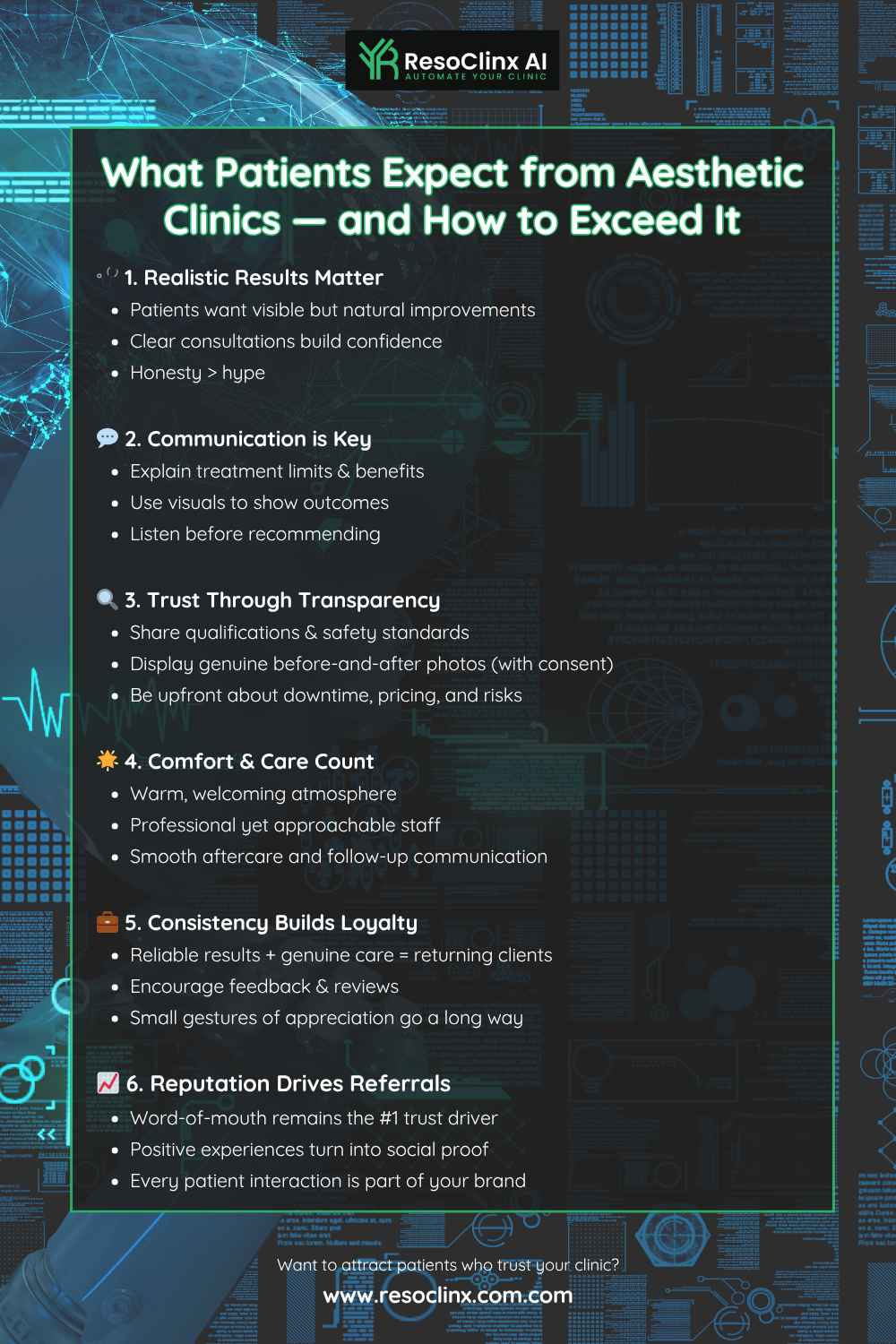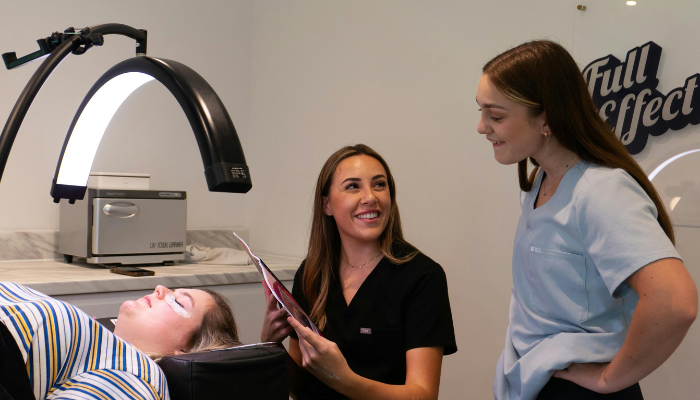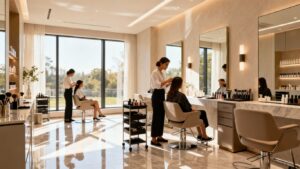Running an aesthetic clinic is both rewarding and demanding. Beyond delivering excellent treatments, clinic owners must juggle client satisfaction, manage unexpected challenges, and ensure their results reflect the highest standards. Add to that the constant evolution of new procedures and the business pressures of staying competitive, and it’s easy to see why marketing can feel overwhelming.
In this article, we’ll explore the key challenges in marketing aesthetic clinics and share practical solutions to help you overcome them — from managing patient expectations to building trust and improving your clinic’s local visibility online.
Key Takeaways
- • Manage Client Expectations: Set realistic goals and communicate openly to prevent disappointment — social media can often distort what’s achievable.
• Be Prepared for Complications: Have clear protocols in place to manage unexpected issues calmly and ensure patient safety at all times.
• Showcase Your Work Professionally: Your portfolio is your clinic’s shop window. Use high-quality, well-lit images that highlight your range of treatments.
• Market Strategically: Combine social media, local SEO, and word-of-mouth referrals to attract more clients to your aesthetic clinic.
• Know Your Numbers: Strong financial awareness and compliance with UK regulations are as vital as your clinical skills.
1. Navigating Patient Expectations

It’s a common challenge in aesthetic clinics: patients often arrive with expectations shaped by social media or celebrity images that may not align with their own features or treatment possibilities. This gap between aspiration and reality is where most challenges begin. Clear, honest communication during the initial consultation is essential for managing expectations effectively.
To put it simply, you wouldn’t promise someone a marathon finish time if they’ve only just started jogging. The same principle applies in aesthetics — clarity about achievable outcomes is vital.
This goes beyond a brief chat; it requires a thoughtful, well-structured discussion about:
- Realistic Outcomes: Gently explaining what a specific procedure can realistically achieve for their individual anatomy and skin type.
- Limitations: Being upfront about what a treatment cannot do, rather than letting a patient discover this later.
- Alternative Options: Suggesting other treatments or a staged approach if their initial request isn’t fully achievable.
- The ‘Less is More’ Approach: Sometimes, subtle enhancements yield the most natural and pleasing results. Guiding patients towards this can be incredibly beneficial.
Visual aids can be very helpful here. Showing carefully selected before-and-after photos (with appropriate consent, of course) can illustrate the range of possible results. It’s also important to listen actively to a patient’s concerns and motivations.
Understanding why they want a particular change can help you guide them towards the best possible solution for their well-being and satisfaction.
Building trust is paramount. When patients feel heard and understand the process, they’re far more likely to be satisfied with their results — even if they differ slightly from their initial vision. Managing expectations isn’t about lowering hopes; it’s about guiding clients towards safe, achievable, and genuinely satisfying outcomes.
2. Managing Complications
Even with meticulous planning and clinical precision, complications can occasionally occur. It’s not a reflection of your ability but a reality of working with the human body. The key is to stay prepared, act promptly, and manage every situation with professionalism and care.
When complications do occur, it’s important to remain calm and focused. Prompt and appropriate intervention is paramount for patient safety and positive outcomes.
This might involve immediate first aid, administering specific medications, or, in more serious cases, referring the patient to a specialist or hospital.
Here are some common complications and how to approach them:
- Infection: This can happen if hygiene protocols aren’t strictly followed. Signs include increased redness, swelling, pain, and possibly fever. Treatment usually involves antibiotics. Prevention is key, so rigorous sterilisation and aseptic techniques are non-negotiable.
- Inflammation and Swelling: Often a normal part of the healing process, but excessive or prolonged swelling can be concerning. Cold compresses and anti-inflammatory medication can help. Monitoring the patient’s response is important.
- Bruising: Common with injectables, bruising is usually minor and resolves on its own. Applying pressure immediately after treatment and advising patients to avoid certain medications or activities can minimise it.
- Allergic Reactions: These can range from mild skin rashes to severe anaphylaxis. Having emergency medications like antihistamines and adrenaline readily available is vital. Always take a thorough patient history to identify potential allergens.
- Scarring: While rare with modern techniques, scarring can occur, especially if an infection develops or a treatment is too aggressive. Careful technique and proper aftercare are the best defences.
It’s vital to have a robust system for documenting every complication, no matter how minor. This not only helps in tracking patient recovery but also provides valuable data for refining your own procedures and training future practitioners. Transparency with the patient throughout the process is also key; they need to understand what happened, why, and what the plan is for their recovery.
Regularly update your knowledge on complication management through CPD courses and accredited workshops. The aesthetic field evolves quickly, and staying informed ensures you’re always prepared to manage any situation confidently and safely.
3. Building A Professional Portfolio
Your portfolio is your visual CV in the aesthetics industry. It showcases your expertise, experience, and the results you can deliver to potential clients and employers alike. A well-curated portfolio is absolutely essential for building trust and attracting new business.
To create a strong portfolio, focus on professional-quality visuals. Invest in good lighting and ensure images are clear, consistent, and ethically edited. Include a variety of treatments to demonstrate your range and versatility.
Before-and-after photos are incredibly effective, but always remember to get explicit consent from your clients before using their images. Documenting your work from the start, even during training, is key.
Here’s what to aim for in your portfolio:
- High-Quality Before-and-After Photos: These are your most powerful tool. Ensure they are well-lit, show consistent angles, and clearly demonstrate the results of your treatments.
- Variety of Treatments: Showcase your skills across different procedures you offer, from injectables to skin rejuvenation.
- Client Testimonials: Positive feedback from satisfied clients adds credibility. Ask for written or video testimonials (with permission, of course).
- Case Studies: For more complex treatments, a brief case study detailing the client’s concerns, your treatment plan, and the outcome can be very insightful.
- Certificates and Qualifications: Include copies of your relevant training certificates to demonstrate your credentials.
Your portfolio should be a living document, regularly updated with your latest and best work. It’s not just about showing what you’ve done, but also about showcasing your unique style and approach to treatments. Make it easily accessible, perhaps through a dedicated section on your website or a professional online platform.
Consistency in presentation matters. Whether digital or printed, your portfolio should look polished and reflect the professionalism and quality standards of your clinic.
4. Marketing Your Laser Services

Promoting your laser services effectively is essential to growing your clinic. It’s not enough to offer excellent treatments — you must ensure the right people know about them. Think of marketing as your way to connect with individuals actively seeking the solutions you provide.
A well-rounded marketing approach combines online and offline strategies to reach a wider audience.
Here are some ways to get the word out:
- Your Website: This is your digital shopfront. Ensure it’s user-friendly, visually professional, and clearly lists your laser treatments. Include high-quality before-and-after photos and optimise your site for local SEO so potential clients can easily find you online.
- Social Media: Platforms like Instagram and Facebook are great for showing off your work. Short videos demonstrating treatments or explaining how they work can be really engaging. Use them to build a community and interact with potential clients.
- Email Marketing: Don’t underestimate the power of email. Building an email list allows you to stay in touch with past clients and nurture new leads. You can share special offers, introduce new treatments, or just send out helpful tips.
- Local Partnerships: Team up with other local businesses. Think about collaborating with hair salons, gyms, or even other medical professionals. This can introduce your services to a whole new group of people.
- Paid Advertising: Consider using targeted ads on social media or search engines. This can be a quick way to get your message in front of people who are actively searching for laser treatments.
When planning your marketing, always think about who you’re trying to reach. What are their needs? Where do they spend their time online and offline? Tailoring your message to them will make your efforts much more effective. It’s about speaking directly to their concerns and showing them how your laser services can help.
It’s also a good idea to keep an eye on what other clinics are doing. What services are popular? How are they reaching their clients? You don’t want to copy them, but it can give you ideas on how to stand out and find your own unique selling points.
5. Understanding Business Basics In Aesthetics
Running a successful aesthetic clinic involves more than clinical excellence — it requires solid business foundations and operational structure.
Many practitioners focus heavily on their clinical skills, which is understandable, but overlooking the fundamentals of business management can really hinder growth and even lead to problems down the line. It’s about balancing your passion for aesthetics with a practical approach to running a company.
One of the most common pitfalls is not having a clear financial plan. This isn’t just about tracking income and expenses; it’s about understanding your profit margins, managing cash flow, and setting realistic financial goals. Without this, it’s easy to overspend or underestimate costs, putting your business under unnecessary strain.
Here are some key areas to focus on:
- Financial Management: This includes budgeting, bookkeeping, and understanding your tax obligations. Knowing your numbers inside out is vital for making informed decisions.
- Marketing and Sales: How are you attracting new clients and keeping existing ones happy? A solid marketing strategy, whether online or offline, is essential for visibility.
- Operations: This covers everything from scheduling appointments and managing inventory to ensuring your clinic is compliant with all relevant regulations.
- Customer Service: In aesthetics, client relationships are paramount. Providing an excellent experience from the first contact to aftercare builds loyalty and positive word-of-mouth.
It’s easy to get caught up in the day-to-day treatments, but taking time to understand and implement sound business practices is not a luxury; it’s a necessity for long-term success and sustainability in the competitive aesthetic market.
Don’t be afraid to seek advice. Many successful clinic owners started with limited business knowledge and learned as they went. There are plenty of resources available, from online courses to business mentors, that can help you get a handle on the commercial side of aesthetics.
Investing time in understanding these business basics will pay dividends, allowing you to focus on what you do best – providing exceptional aesthetic treatments.
6. Staying Updated In The Aesthetic Industry

The world of aesthetic medicine evolves rapidly. What was cutting-edge last year may already be standard practice today, and new treatments, technologies, and even regulations seem to emerge constantly. For practitioners, keeping up isn’t just about staying relevant; it’s about providing the safest, most effective care and ensuring your business continues to thrive.
Think of ongoing education as your professional toolkit. It’s what keeps your skills sharp and your knowledge current. Regularly updating your qualifications shows clients you’re committed to offering the best and safest treatments available. It also opens doors to new specialisations and opportunities you might not have considered before.
Here are a few ways to make sure you’re always in the know:
- Attend Industry Conferences and Workshops: These events are goldmines for learning about the latest advancements, seeing new technologies in action, and hearing directly from experts. They’re also fantastic for networking.
- Join Professional Associations: Many associations offer resources, training materials, and regular updates on industry news and best practices. Being part of a community means you’re not alone in navigating these changes.
- Read Industry Publications and Follow Reputable Sources: Keep an eye on well-respected journals, trade magazines, and trusted online platforms. Be discerning, though – always cross-reference information and stick to credible sources.
- Engage in Continuous Professional Development (CPD): Look for advanced courses and specialised training that align with your interests. This could be anything from mastering a new injectable technique to understanding the latest laser technology.
The aesthetic industry is dynamic. Embracing continuous learning isn’t just a recommendation; it’s a necessity for maintaining high standards, adapting to client needs, and building a sustainable career. It’s an investment in yourself and the quality of care you provide.
By actively seeking out new knowledge and skills, you’ll not only stay ahead of the curve but also build greater confidence in your practice and offer your clients the most up-to-date and beneficial treatments available.
7. Building A Successful Aesthetic Career
Embarking on a career in aesthetics is an exciting prospect, but turning that ambition into a sustainable and thriving profession requires more than just technical skill. It’s about building a reputation, connecting with clients, and understanding the business side of things. While it might seem a bit daunting at first, with a thoughtful approach, you can certainly make it work.
Your professional reputation is built not just on your clinical skill, but on how you communicate, educate, and engage with clients. It’s the visual evidence of your capabilities, showcasing your best work to potential clients. Think of it as your professional story told through images.
Building Your Brand
High-quality photographs are non-negotiable; invest in good lighting and editing to present your treatments in the best possible light. Ensure your portfolio includes a diverse range of treatments you’re proficient in, and always remember to obtain explicit client consent before sharing before-and-after images.
Marketing yourself effectively is just as important. After all, no one will know how skilled you are if you don’t tell them! Social media can be a powerful ally here, but don’t discount more traditional methods either.
Use platforms to showcase your work, share client testimonials, and engage with potential clients. Consider local advertising, such as flyers or partnerships with complementary businesses like salons. And never underestimate the power of word-of-mouth; encourage satisfied clients to spread the word.
Beyond the treatments themselves, a solid grasp of business basics is vital. This includes managing finances, understanding relevant regulations, and, crucially, providing excellent customer service. Happy clients are loyal clients, and loyalty is the bedrock of a successful practice.
Here are some key areas to focus on:
- Continuous Learning: The aesthetic industry evolves rapidly. Dedicate time to ongoing education, workshops, and staying abreast of new techniques and technologies. This commitment not only keeps your skills sharp but also demonstrates your dedication to providing the best possible care.
- Client Relationships: Building trust and rapport is paramount. Listen attentively to your clients’ concerns, manage their expectations realistically, and ensure they feel heard and understood throughout their journey.
- Business Acumen: Develop a basic understanding of financial management, marketing strategies, and operational efficiency. Even if you plan to hire staff later, knowing the fundamentals will help you make informed decisions.
- Networking: Connect with other professionals in the industry. Attend events, join associations, and engage in online communities. These connections can provide support, mentorship, and lead to unexpected opportunities.
Building a successful career in aesthetics is a marathon, not a sprint. It requires a blend of artistic talent, clinical precision, and sound business sense. By focusing on continuous improvement, client satisfaction, and smart business practices, you can create a fulfilling and prosperous career path.
8. Choosing The Right Aesthetic Course
So, you’ve decided to take the plunge into the world of aesthetic medicine. That’s fantastic! But with so many courses out there, it can feel a bit like navigating a maze. Don’t worry, we’ll help you find your way.
First off, be honest with yourself about your current skills. Are you a complete beginner, or do you have some background in beauty or healthcare? Knowing your starting point is key to picking a course that’s going to genuinely help you grow, rather than leaving you feeling completely out of your depth. Jumping into an advanced course without the fundamentals is just asking for trouble.
Next, think about what you actually want to achieve. Are you hoping to add a few new treatments to your existing practice, or do you dream of opening your own clinic one day? Perhaps you’re really drawn to a specific area, like laser treatments or injectables. Your career goals will really shape the kind of course you should be looking for.
Here’s a breakdown of what to consider:
- Your Current Skill Level: Beginner, intermediate, or advanced?
- Your Career Aspirations: Adding to existing practice, starting your own, or specialising?
- Course Content: Does it cover the treatments you’re interested in?
- Accreditation: Is the course recognised by a reputable professional body? This is really important for insurance and credibility.
- Practical Experience: How much hands-on training will you get? Look for courses that offer plenty of practice on models.
- Learning Style: Do you prefer in-person classes, online modules, or a hybrid approach?
When you’re comparing courses, don’t just look at the price tag. A cheaper course might seem appealing, but if it lacks proper accreditation or sufficient hands-on training, it could end up costing you more in the long run through missed opportunities or even complications. Always prioritise quality and safety.
It’s also worth looking into the instructors themselves. Are they experienced practitioners with a good track record? Do they have professional registrations? A good training provider will be transparent about their trainers’ backgrounds.
Don’t be afraid to ask questions; a reputable provider will be happy to answer them. If they seem vague or evasive, that’s a bit of a red flag.
9. Networking In The Aesthetic Industry
Building connections in the aesthetic industry is more than just a nice-to-have; it’s a fundamental part of growing your career and your business. Think of it as creating your own support system and knowledge hub. When you connect with other professionals, you open doors to shared experiences, advice, and even potential collaborations. It’s about building a community where you can learn from others and, in turn, share your own insights.
Here are a few ways to get started with networking:
- Attend industry events: Conferences, workshops, and trade shows are fantastic places to meet people. Make a plan to introduce yourself to at least three new people at each event.
- Join professional associations: Organisations dedicated to aesthetic medicine often have member directories and host local meetups. This is a great way to find like-minded individuals.
- Engage online: Participate in relevant forums, LinkedIn groups, and social media discussions. Share your thoughts and respond to others to build your online presence.
- Connect with suppliers and manufacturers: The people who provide your equipment and products are often well-connected and can offer introductions.
Building a strong network takes time and consistent effort. It’s not just about collecting business cards; it’s about nurturing relationships. Be genuine, offer help where you can, and remember that these connections can be invaluable for advice, support, and staying ahead of industry trends.
Don’t underestimate the power of simply talking to colleagues. Sharing challenges and successes with peers can provide fresh perspectives and solutions you might not have considered on your own. A well-connected practitioner is often a more informed and resilient one.
10. Ethical Challenges Related To Misleading Ads

In the world of aesthetic clinics, advertising plays a huge role in attracting clients. However, it’s a tricky area where ethical lines can easily get blurred. We’ve all seen adverts that overpromise — portraying treatments as instant fixes for everything from confidence to career success.
This kind of marketing can prey on people’s insecurities, which isn’t really fair, is it?
The core issue arises when advertising creates unrealistic expectations that treatments cannot genuinely deliver. This not only misleads potential clients but also damages the reputation of the entire industry. It’s important for clinics to be honest and transparent in their marketing efforts.
Here are a few things to consider when creating your marketing materials:
- Focus on realistic outcomes: Instead of promising a complete life transformation, highlight the specific, achievable results of your treatments. Use clear language about what clients can expect.
- Showcase genuine results: If you use before-and-after photos, ensure they are unedited and represent typical results. Always get explicit consent from clients before using their images.
- Be clear about limitations: Acknowledge that results can vary between individuals and that some treatments may require multiple sessions or have downtime.
- Avoid sensationalism: Steer clear of language that exaggerates benefits or implies a quick fix for complex issues.
It’s vital that marketing reflects the actual services provided and respects the client’s intelligence and emotional state. Building trust through honesty is far more beneficial in the long run than any short-term gain from misleading claims.
Ultimately, ethical advertising isn’t just about avoiding trouble; it’s about building a sustainable and reputable business. By being upfront and honest, you’ll attract clients who are a good fit for your services and foster long-term loyalty.
Moving Forward with Confidence
Navigating the aesthetic clinic industry presents unique challenges — from standing out in a competitive market to building lasting client relationships. However, these challenges are entirely manageable.
By focusing on strategic marketing, strong business foundations, and consistent patient care, you’re already positioning your clinic for success.
Frequently Asked Questions
What are the biggest hurdles when marketing an aesthetic clinic?
One of the main challenges is simply getting noticed because there are so many clinics out there now, making it a very competitive field. Another big issue is getting people to choose your clinic over others, which often comes down to how well you advertise and connect with potential clients. Plus, keeping up with all the new treatments and technology can be a real headache.
How can I make my aesthetic clinic stand out from competitors in my local area?
To stand out, focus on what makes your clinic special. This could be the unique treatments you offer, the amazing customer service you provide, or even the special atmosphere you create. Really understanding what your clients want and offering them something tailored to their needs can make a huge difference. Also, make sure your advertising clearly shows why you're different and better.
What’s the best way to attract new clients to my aesthetic clinic through digital marketing?
Getting new clients involves a mix of things. A great website that shows off your services with good photos is a must. Using social media to share your work and talk to people is also super important. Don't forget about local advertising, like flyers, and making sure your clinic shows up when people search online for treatments nearby. Encouraging happy clients to tell their friends is also a powerful way to get new business.
Why is understanding the business side essential for running a successful aesthetic clinic?
Being brilliant at treatments is only half the story. You also need to know how to manage your money, follow all the important rules and safety guidelines, and make sure your clients are really happy. If you don't get the business side right, even the best clinic can struggle. It's about making sure the clinic runs smoothly and makes money so you can keep helping people.
How can I keep my skills and knowledge up-to-date in the fast-changing aesthetics industry?
The world of aesthetics moves incredibly fast, so you have to keep learning. This means going to training courses, attending workshops, and reading up on new treatments and technologies. Joining professional groups and talking to other practitioners is also a great way to stay informed and learn from their experiences. It’s all about making sure you’re offering the safest and most effective treatments available.
What are some common ethical issues in aesthetic clinic advertising?
A big problem is when ads make treatments sound like a magic fix for all of life's problems, or show unrealistic 'perfect' results that can't actually be achieved. This can mislead people and exploit their insecurities. It's important to be honest about what treatments can do, show realistic outcomes, and avoid making promises that can't be kept. Ethical advertising builds trust.






